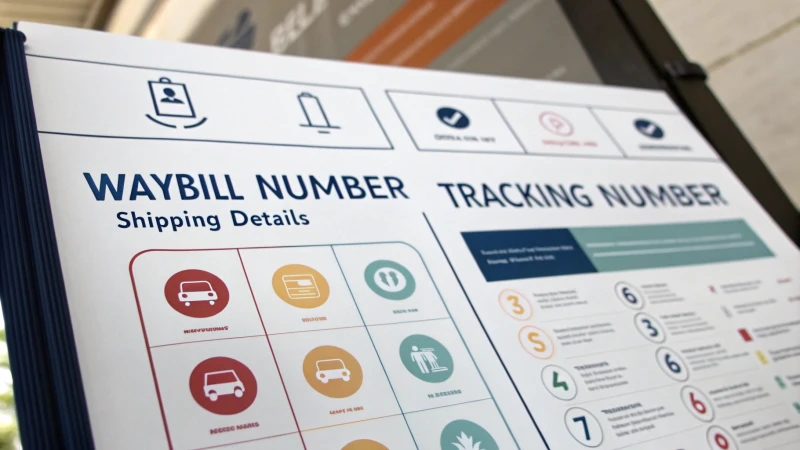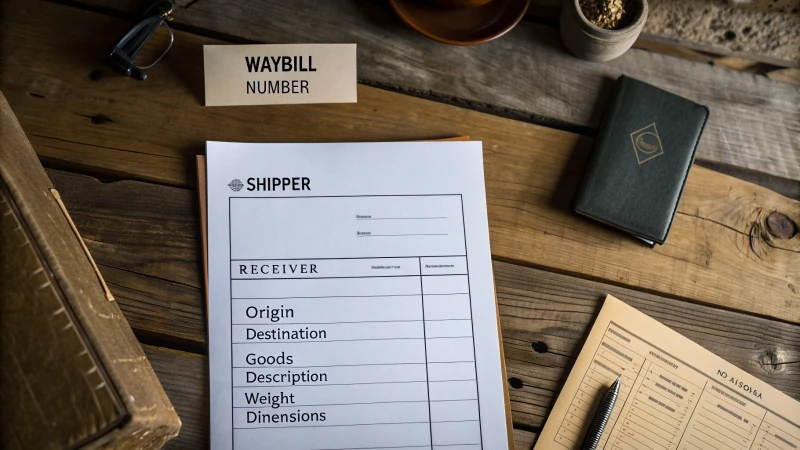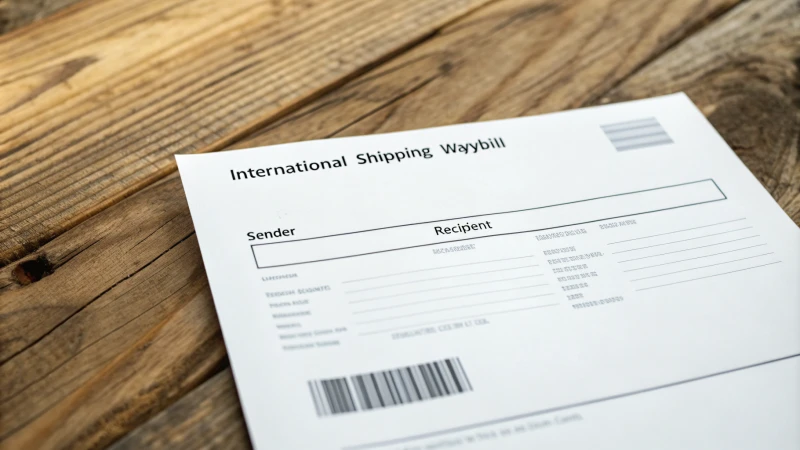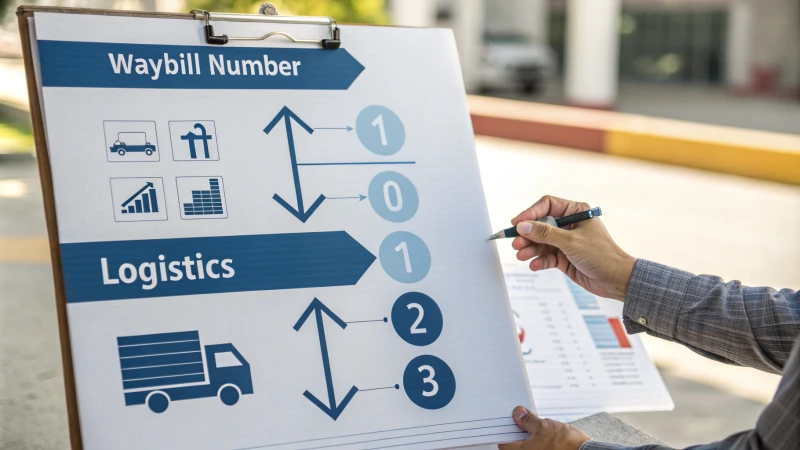Picture this: you're eagerly waiting for a package, but the journey seems endless. That's where a waybill number comes in, making tracking your shipment as easy as pie.
A waybill number is like a passport for your shipment. It’s a unique code issued by shipping carriers that lets you track your package’s journey from start to finish. It also acts as a legal promise that your goods will be transported safely and as agreed.
So, imagine you've just ordered some amazing gadgets from overseas for your business. You've invested not just money, but also hopes and dreams into this shipment reaching you safely. That's when the waybill number becomes your best friend. It’s more than just a series of numbers; it’s the peace of mind that your shipment is being handled with care.
Think of it this way: while it's easy to see it as just another detail in the shipping process, the waybill number ensures everyone involved—from the shipper to the carrier to you—knows exactly what's happening with your precious cargo. That little number is your eyes and ears on the ground, making sure your shipment is on the right path, right on time.
A waybill number is used to track shipments.True
Waybill numbers are unique identifiers that allow tracking of shipment status.
A waybill number serves as a legal contract.True
It ensures the carrier's responsibility for transporting goods as agreed.
How Do Waybill Numbers Differ from Tracking Numbers?
Ever wondered why your shipment has both a waybill and a tracking number? These tiny digits hold big responsibilities in the logistics world!
A waybill number is like a contract binding the sender and carrier, detailing shipment specifics, while a tracking number focuses purely on updating you on your package's journey.

The Role of a Waybill Number
Let me take you on a little journey. Imagine sending a package and needing assurance that it's more than just a parcel on a conveyor belt—it's a legal entity in transit. That's where a waybill number1 steps in. Picture it as the passport for your shipment, packed with vital details like where it’s coming from, where it’s headed, and what’s inside. It's not just about logistics; it's about accountability.
I recall the first time I shipped a bulk order overseas. As I handed over my goods, that waybill number felt like a badge of trust. It confirmed that my shipment was in good hands, with every detail documented and ready for scrutiny if needed.
| Function | Description |
|---|---|
| Contract of Carriage | Binds carrier to transport goods according to agreed terms. |
| Receipt of Goods | Confirms carrier has accepted the shipment. |
| Auditing | Provides a reference for verifying shipment details. |
Understanding Tracking Numbers
Now, the tracking number2 is like your personal detective, diligently following every step of the package's journey. It gives you real-time updates, transforming the abstract wait into an engaging story of transit.
The excitement of watching my package travel from one hub to another is an experience I cherish. It's like living vicariously through the parcel's journey. Knowing exactly where my shipment is helps me keep my customers informed and satisfied, especially when those tracking updates predict delivery times almost down to the hour.
| Function | Description |
|---|---|
| Real-Time Updates | Enables tracking of parcel movements through each transit point. |
| Customer Service | Assists in resolving shipping issues by providing detailed transit logs. |
Key Differences and Use Cases
The key distinction between these numbers is their role in the grand scheme of shipping operations. For someone managing a wholesale business like mine, this understanding is invaluable. The difference between waybill and tracking numbers3 is all about perspective.
With waybills, it's about ensuring that my shipments are legally sound and every piece of inventory is accounted for. Tracking numbers, on the other hand, allow me to offer transparency and peace of mind to my customers, ensuring they know exactly when to expect their new gadgets.
Understanding these distinctions empowers businesses to optimize their shipping processes and improve overall efficiency in supply chain management.
Why Understanding Both Matters
Mastering both these concepts has been a game-changer for my business operations. It means I can navigate through regulations smoothly while keeping my promises to customers regarding delivery times.
This knowledge isn't just theoretical; it's practical and vital for optimizing shipping strategies4. It helps streamline processes, reduce errors, and foster stronger relationships with logistics partners.
Ultimately, distinguishing between these two identifiers has made my logistics processes more efficient and customer service more reliable, empowering me to tackle the competitive market head-on.
Explore more on effective shipping strategies5. Delving into these fundamentals has profoundly impacted my logistical efficiency and customer satisfaction levels, propelling my business forward.
A waybill number acts as a legal contract of carriage.True
The waybill number binds the carrier to transport goods per agreed terms.
Tracking numbers are used for auditing shipment details.False
Tracking numbers provide real-time updates, not for auditing shipment details.
What Information Does a Waybill Include?
Ever wondered what keeps your shipments secure and on the right track? Dive into the world of waybills and discover the magic behind their detailed information.
A waybill is your shipping lifeline, packed with critical information like the shipper and receiver's details, shipment origin, destination, a description of the goods, their weight and size, and a unique waybill number for tracking.

Understanding Waybill Components
Imagine sending off a shipment without knowing if it will reach its destination safely. That's where waybills come in—they're like a trusty roadmap for your cargo. I've been there, standing in my warehouse, feeling the weight of responsibility as I hand over goods worth thousands. It's reassuring to know that every piece of information on a waybill plays a crucial role. Here's what it includes:
| Component | Description |
|---|---|
| Shipper Details | Includes name, address, and contact of the sender. |
| Receiver Details | Contains recipient's name, address, and contact info. |
| Shipment Origin | The starting point of the shipment journey. |
| Destination | Final destination where goods are to be delivered. |
| Description | Detailed description of goods being transported. |
| Weight & Size | Lists weight and dimensions of the shipment package. |
| Waybill Number | A unique identifier for tracking the shipment's progress. |
The Role of Tracking Information
I remember anxiously refreshing my tracking page during my first major shipment. The waybill number6 was my savior, offering real-time updates that calmed my nerves. It's not just a number; it's a bridge connecting shippers, carriers, and recipients, ensuring everyone stays informed.
- Real-Time Tracking: Provides live updates about the location and status of the shipment.
- Communication: Facilitates smooth communication between shippers, carriers, and recipients.
Legal Implications and Responsibilities
Handling logistics can sometimes feel like walking a tightrope, but waybills are there to balance things out. As a legal contract of carriage7, they outline who is responsible for what, keeping everyone accountable.
- Carrier Liability: Defines what happens if goods are damaged or lost during transit.
- Proof of Shipment: Acts as evidence that goods have been handed over to the carrier.
Understanding waybills is like holding the keys to smooth operations in the supply chain. They're not just documents; they're safeguards ensuring every transaction is backed up with proof and precision. If you're curious about how waybills stack up against other shipping documents, you might want to explore bills of lading and their unique features.
Waybills include the shipment's weight and size.True
Waybills list the weight and dimensions of the shipment package.
Waybills do not provide tracking information.False
Waybills include a unique waybill number for tracking shipments.
Why is a Waybill Number Important in International Shipping?
I remember my first big shipment. The anticipation and anxiety of sending goods overseas were overwhelming, but then I discovered the waybill number's magic.
A waybill number is crucial in international shipping as it uniquely identifies and tracks shipments, establishes a legal contract, and confirms the carrier's responsibility for the goods.

Key Functions of a Waybill Number
I can still recall when I first started importing goods from China. It was a nerve-wracking experience, but understanding the role of the waybill number8 gave me confidence. Here’s why it's such a game-changer:
-
Tracking: Imagine the relief of knowing exactly where your shipment is at any given moment. The waybill number lets shippers like me, carriers, and recipients keep tabs on a package’s journey. It's like having a GPS for your goods, ensuring you can tackle any supply chain hiccup head-on.
-
Contract of Carriage: Back in the early days, I learned the hard way about the importance of binding agreements. The waybill number serves as a legal contract with the carrier, ensuring they're bound to transport your goods as promised, which protects everyone's interests.
-
Receipt of Goods: Whenever I handed over products to a carrier, that waybill number acted as my safety net—a receipt confirming they’d received my shipment. It’s a vital acknowledgment that keeps accountability clear.
| Function | Description |
|---|---|
| Tracking | Monitors shipment status and location throughout its journey. |
| Contract | Legal agreement binding the carrier to transport the goods. |
| Receipt | Confirms carrier receipt and responsibility for the shipment. |
The Role in Customs Clearance
Navigating customs can feel like solving a complex puzzle, especially with international shipping. A waybill number eases this process by offering customs officials all the necessary shipment details, simplifying paperwork and reducing chances of delays.
Differentiating from Other Numbers
When I was just starting, I often confused waybill numbers with other identifiers like tracking or order numbers. However, while tracking numbers9 mainly provide shipment updates, a waybill number is more comprehensive, covering contractual obligations and receipt confirmations. Understanding these nuances can significantly enhance logistics efficiency.
Ensuring Supply Chain Efficiency
Efficient logistics come down to clear communication and reliable tracking—something I've learned is non-negotiable in my trade. The waybill number is key to maintaining this clarity. For anyone involved in import/export trade10, leveraging this tool means ensuring your goods are handled promptly, minimizing potential disruptions or losses. It's all about making sure everything runs smoothly so you can sleep soundly at night.
A waybill number is only for tracking shipments.False
A waybill number also acts as a contract and receipt.
Waybill numbers simplify customs clearance processes.True
They provide necessary details to customs, reducing delays.
Conclusion
A waybill number is a unique identifier for shipments, serving as a tracking tool, legal contract, and receipt of goods, ensuring accountability in logistics.
-
Discover how waybill numbers serve as contracts and receipts in shipping. ↩
-
Learn how tracking numbers provide real-time parcel updates. ↩
-
Understand the key differences between these two critical shipping identifiers. ↩
-
Explore strategies to optimize your shipping operations effectively. ↩
-
Learn methods to enhance logistical efficiency and customer satisfaction. ↩
-
Learn how to effectively use waybill numbers to monitor shipments in real-time. ↩
-
Understand the legal role of waybills as contracts of carriage in shipping. ↩
-
Explore this link to understand what constitutes a waybill number and its various applications in shipping. ↩
-
This link clarifies the differences between these numbers, crucial for effective logistics management. ↩
-
Discover strategies to leverage waybill numbers for smoother import/export operations. ↩




